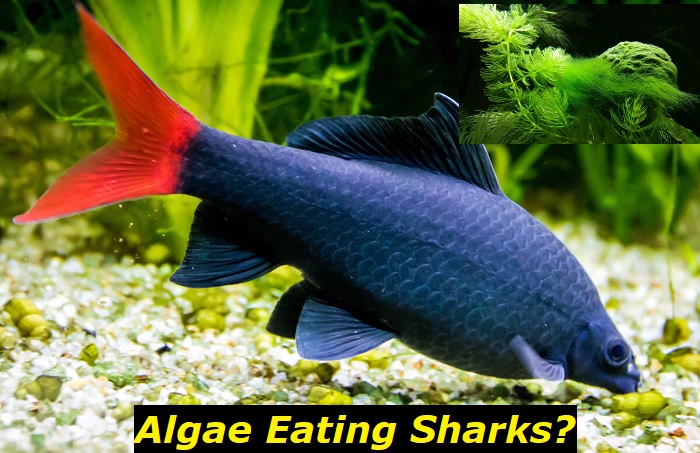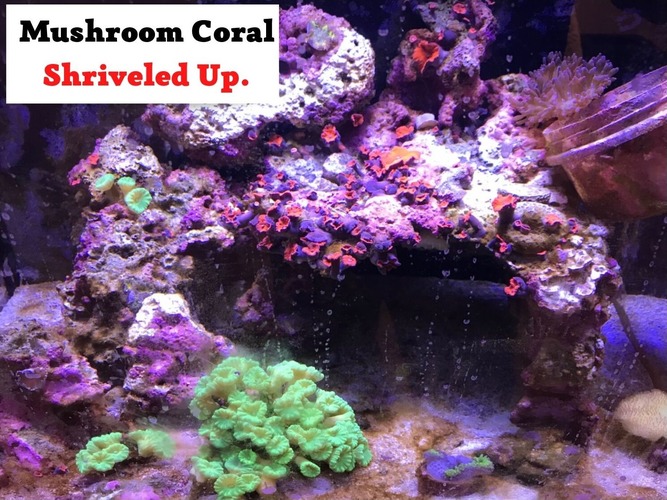Having a shark in your aquarium with other fish is a wild idea. There is an excellent chance that these wild and imposing predators will eat your smaller fish in minutes. Although many true sharks eat algae, directly and indirectly, this does not make them an excellent option for your tank.
But there are other sharks that eat algae and are great for your tank.

This article discusses them and why they are the only good sharks for your tank. You will learn the following:
- Whether there is a specific species called shark algae eater;
- Why shark algae eater is the only good shark in your tank;
- Some excellent shark algae eaters you should know.
Are there any specific fish species called Shark Algae Eater?
It is common to find pet store attendants repeatedly telling you that a fish species is a shark algae eater. They are wrong. Most times, they are completely clueless about the fish species in the pet store.
There is no fish specifically called shark algae eaters. But some species look like sharks and eat algae. So unless the term “shark algae eater” means a group of fish that look like sharks and eat algae, it would be inaccurate to name particular species “Shark algae eater”.
Shark algae eaters include the Siamese algae eater, Red tail shark, Rainbow shark, Chinese algae eater, Flying fox, Bala sharks, Violent blushing shark, Harlequin sharks, Chinese high-fin banded sharks, etc.
While some are prolific algae eaters, others are merely browsers and will make a bad choice if you want an active algae eater.
Why is Shark Algae the only good shark to have in your tank?
Algae is a plant species that thrives on light, water, and nutrients. So, it is logical that they will appear in your aquarium. However, while normal algae growth is beneficial and healthy for the aquarium, too much algae in the aquarium is bad for the aquarium.
This is why many aquarists keep Shark algae eaters in the tank.
Increase the level of dissolved oxygen in the water
An algae bloom can lead to oxygen depletion in the aquarium water. This can have a serious impact on the health of your fish and even lead to death. But shark eaters can help you reduce that possibility.
Naturally, algae, like many other aquatic plants, produce oxygen and sugar in the process of photosynthesis. They require light and nutrients in the aquarium water to produce oxygen. But at night or when the light is dim for a long period, as during a cloudy day, algae remove oxygen from the water in the aquarium for respiration, especially when the oxygen level is very high and even threatening.
Algae bloom that results in too much algae can cause the removal of more oxygen than was produced. When the oxygen level of your aquarium water is low, your fish will begin to struggle for oxygen, leading to suffocation and death.
But your shark algae eater can increase the level of dissolved oxygen in the tank by checking the algae growth and preventing an algae bloom.
Keeping a clearer tank
Having shark algae eaters in the tank increases the level of dissolved oxygen in the tank and helps you maintain a clean tank.
With too much algae in the tank, you are bound to end up with a blurry and grimy tank. This is the case with many aquarists who end up with a green and invisible tank because of the scattering of algae particles in the water.
Keeping a few shark algae eaters in the tank checks the algae bloom in your tanks, which helps you keep a clearer tank.
Some Prolific Shark Algae Eaters
There are some fish that remotely (sometimes very remotely) look like sharks and eat algae. These fish species can be properly categorized as shark algae eaters. These fish species include the following:
Siamese Algae Eater (Crossocheilus oblongus)
If you are looking for a renowned algae eater that can tidy up your aquarium and rid it of algae, this is the fish for you. This cyprinid is a peaceful bottom-dwelling freshwater fish endemic to Southeast Asia.
It is a popular fish in the aquarium hobby because of its role in the aquarium. It voraciously eats algae in the tank. It is a well sought-after fish for this role in the aquarium hobby and is reputed as the best shark algae eater.
It has a long pale gray or gold body. It can reach a maximum of 6 inches in length. True Siamese algae eaters usually have a black stripe that runs from their heads to their caudal fin.
Chinese Algae Eater (Gyrinocheilus aymonieri)
The Chinese algae eater is another prolific shark algae eater. It is not very popular in the hobby because it does not have vibrant colors and patterns like many other popular freshwater sharks in the hobby.
This fish is also a cyprinid. It is not exclusive, as the name may suggest. Apart from the Yunnan province in China, it is also common in the Chao Phraya basin and many other freshwater bodies in Laos, Vietnam, and the Malay Peninsula.
The most striking feature of this fish is its mouth. It has an impressively large mouth for fish its size. With its mouth and its sizeable lips, it can latch onto a smooth surface by creating suction power.
As its name suggests, it is another excellent algae eater you want to keep in your aquarium.
Rainbow Shark (Epalzeorhynchos frenatum)
Rainbow sharks are impressive aquarium fish that also have a reputation for eating algae. They are also cyprinids and are very prolific algae eaters. Apart from having a shark’s shape, one distinct body feature they have is their red fins. But sometimes, these red fins may take on a pink color.
In the wild, they eat a lot of plant matter, insect larvae, and insects. But in the aquarium, hobbyists observe that they are prolific algae eaters when they are young. As they grow older, they become picky and prefer flakes and pellets.
If you choose to keep this bottom-dwelling freshwater shark as your algae eater, then you want to avoid housing it with other bottom dwellers like cories and many others. The rainbow sharks can be very territorial with the rocks and caves they choose as their territory. You also want to avoid housing it with Bala sharks, Red tail sharks, and Cichlids.
Red Tail Shark (Epalzeorhynchos bicolor)
Also known as the Red-tailed black shark, Labeo shark, and Firetail shark in the aquarium hobby, this cyprinid is a medium-sized freshwater shark.
It is pretty aggressive, even against members of its species, and can grow up to 6 inches in length. It has a black body and a very vibrant red caudal fin. Its body is streamlined, and its snout is protruded.
In the wild, these omnivores are scavengers. They spend their time sucking up algae from the surfaces of rocks on the river bed, eating up plant matter and detritus. They also eat smaller animals like crustaceans and worms.
In the aquarium, they eat algae, but you cannot rely on them to clean up your tank, as well as the Siamese algae eater or other algae clean-up crew.
Flying Fox (Epalzeorhynchos kalopterus)
This fish is a southeast Asian cyprinid. It is another popular fish in the hobby and is reputed to be a prolific algae eater. It has a body so similar to the Siamese algae eater that it is often mistaken for the Siamese algae eater.
It is a long body and the shape of a shark. Its average length is about 4 inches, but it can reach 6 inches. These omnivores are largely herbivorous, and they eat algae a lot. They are easy to care for and make a good choice for beginner aquarists. Although they eat algae, they also love other plant matter, smaller animals like crustaceans and worms.
They are excellent for a community tank. But it would be best to keep only one flying fox fish in a tank. The reason is that they are very aggressive and territorial against members of their species.
There are many other freshwater fish that look like sharks and eat algae, as listed above. But the difference here is that they are mostly browsers, while these fish species listed here are voracious algae eaters.
Final Thoughts
True sharks cannot live in freshwater as the environment is very different from their natural habitats. Even if they could, their size and predatory instincts would put your smaller fish species in danger. They would readily become food for the sharks.
But these freshwater sharks are suitable for your freshwater aquariums. They can also cope with a variety of other small fishes. And most importantly, they will keep your tank clean and visible as they munch all that excess algae in your tank.
So, if you are thinking of including sharks that eat algae in your tank, these sharks will do.
- Snail Mantle Collapse – Here’s What Every Pet Owner Should Know - April 2, 2023
- Algaefix Killed My Fish – What Have I Done Wrong? - March 2, 2023
- How Long Can Live Rock Be Out of Water? And What Will Happen Then? - February 2, 2023




